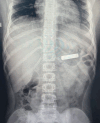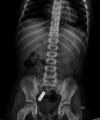Pediatric cylindrical battery ingestion
- PMID: 40018076
- PMCID: PMC11866037
- DOI: 10.1055/a-2526-0108
Pediatric cylindrical battery ingestion
Abstract
Background and study aims: Accidental ingestion of batteries is well documented in pediatric medical literature, but very few data exist in pediatric medical literature about ingestions of cylindrical batteries (CBs). The aim of our study was to evaluate the features, clinical presentation and clinical outcome of children who have ingested CBs.
Patients and methods: All children admitted for CB ingestion were retrospectively recruited. Clinical data until hospital discharge were accurately recorded, including child age and sex, ingestion modality, signs and symptoms following ingestion, type of CB, results of neck-chest-abdominal x-ray performed to assess the retention site of CB, outcome of endoscopic removal, and whether performed.
Results: Forty-five children (males/females: 26/19; age range: 7-168 months; mean age ± standard deviation: 42 ± 33.9 months) were enrolled. Of them, 15 of 45 (33.3%) had ingested AA batteries whereas 30 of 45 (66.6%) had ingested AAA batteries. CBs were retained in the esophagus in two of 45 children (4.4%), in the stomach in 19 of 45 children (42.2%), and in the duodenum or beyond in the remaining 24 of 45 children (53.3%). None of the patients who underwent endoscopic removal (12/45) had any esophageal or gastric mucosal lesions. No cases of intestinal perforation or surgical complications were reported.
Conclusions: According to our study data, conservative management may be advised for the majority of cases of CB ingestion. However, we acknowledge that CB should be timely removed whenever they are A23 or A27 type, damaged prior to ingestion, in cases of multiple ingestion, whenever retained in the stomach for a prolonged period, or whenever a child complains about any clinical signs or symptoms or had undergone prior abdominal surgery.
Keywords: Endoscopy Lower GI Tract; Endoscopy Upper GI Tract; Foreign bodies; Foreign-bodies; Pediatric endoscopy.
The Author(s). This is an open access article published by Thieme under the terms of the Creative Commons Attribution License, permitting unrestricted use, distribution, and reproduction so long as the original work is properly cited. (https://creativecommons.org/licenses/by/4.0/).
Conflict of interest statement
Conflict of Interest The authors declare that they have no conflict of interest.
Figures
References
-
- Denney W, Ahmad N, Dillard B et al.Children will eat the strangest things: a 10-year retrospective analysis of foreign body and caustic ingestions from a single academic center. Pediatr Emerg Care. 2012;28:731–734. - PubMed
LinkOut - more resources
Full Text Sources



